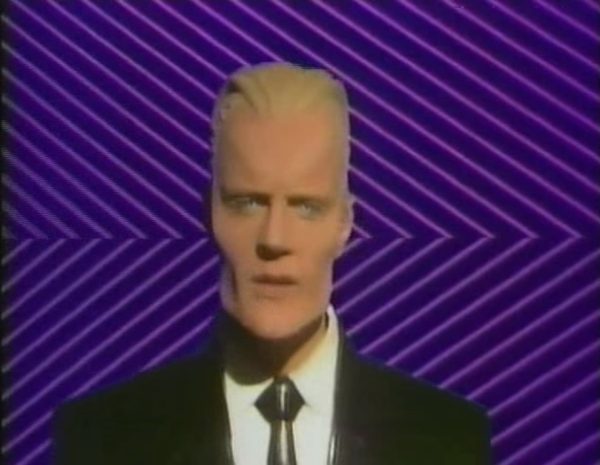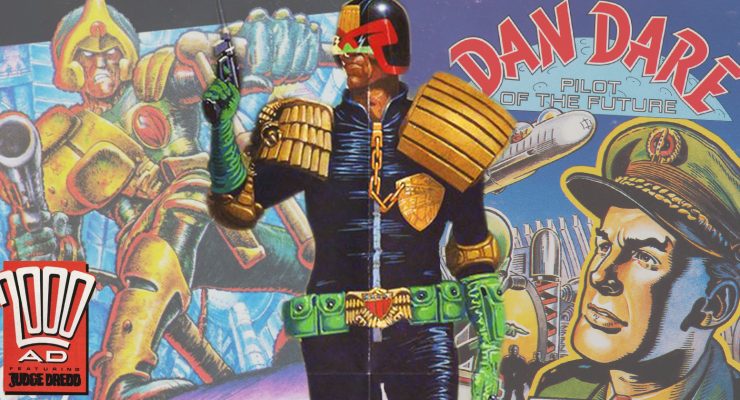Hasitha Fernando dives into the story of Max Headroom…
Of all the strange but unique IPs to debut in the mid-1980s none is more instantly recognizable than the fast talking, social-commentary spewing computer-generated TV host Max Headroom.
First introduced to audiences through the British-made Channel 4 cyberpunk TV movie Max Headroom: 20 Minutes into the Future, which aired in April 1985, the film functioned as the origin story of the snarky Artificial Intelligence (AI) character which became a pop-culture phenomenon. The creation of the creative team of Rocky Morton, Annabel Jankel and George Stone, Max was conceived as part of Channel 4’s effort to offer something fresh and innovative for the country’s youth, enamored with the music video culture popularized by the likes of MTV.
Channel 4 Executive Director Peter Wagg, who played an integral role with the show and the hiring of the uber-talented trio at the very outset had this to say, “MTV was all the rage way back then, and I needed an idea, to sort of, link together music videos while telling a story. The tradition, back in the day, was to have VJs or Video Jocks that were just talking heads that linked the promos together, but I wanted to do something different. At the time I knew these two incredibly talented animators by the name of Rocky Morton and Annabel Jankel who were doing trendy, cutting-edge animations for TV commercials and music videos, and asked the pair if they could do come with a novel concept for our channel.”
Initially the team consisted only of Morton and Jankel, and for the longest time the duo was spit balling ideas, trying to come up with the right idea from an animation perspective and that was when Peter Wagg brought in writer George Stone to the proceedings. “George, Rocky and I hit it off immediately. We would just brainstorm all day, knock ideas around and it was George who actually came up with the name for the show ‘Max Headroom’”, revealed Jankel during a behind-the-scenes interview.
George Stone’s notion for settling on that particular name was because “Max Headroom was over the entranceway of every car park in the UK. Therefore, instant branding and instant recognition”. The name also had the added benefit of suggesting something grander in scope and ambition, which is what they were trying to achieve, “Anything was possible. The world is your oyster. The universe is infinite. It’s maximum headroom,” elaborated Jankel. But that was all that they had, to start with – a catchy name – there was no character or concept in place, and it took Jankel & co. another 18 months to get to the notion of Network 23, Blipverts and the Futureworld, which would eventually be featured in the TV Movie, Max Headroom: 20 Minutes into the Future.
The idea for the concept of Max being a talking head: a middle-class white male in a suit, was something that the team decided upon during that two-year brainstorming period. Having witnessed the radical ideas explored by television networks across the pond, over in the USA, inspired Morton and Jankel to take a more conventional approach albeit with a twist. Morton thought that having the host be computer generated or animated was the way to go, however, this proved to be a challenge as visual effects had not reached a level required to execute to something as complex as this. And this is where old-school creativity and Matt Frewer came in.
Canadian-American actor Matt Frewer was an up-and-coming theatre actor before getting his big break as the now iconic character Max Headroom. Frewer auditioned for the role solely on the suggestion of one of his friends and when Jankel saw his casting Polaroid photo, she thought that Frewer possessed “unbelievably well-defined features” which would make him the perfect choice to embody a person whose appearance was replicated by a computer. Frewer aced his audition, when the comedic improvisation he did for over ten minutes, impressed the production crew.
Taking inspiration from another TV character called Ted Baxter of The Mary Tyler Moore Show, Frewer elaborated that he “particularly wanted to get the phony bonhomie of Baxter.” In addition, Peter Wagg wanted to create a “composite human being” by melding different media personalities like Johnny Carson or Terry Wogan into one character, making him as compelling as the music videos that he was linking up. Max Headroom’s classic look is made up of a shiny dark suit paired with a Ray-Ban Wayfarer sunglasses. The shades were adopted to the overall look as a viable alternative to the bright contacts that Frewer initially had to wear which were painful to his eyes.
The character of Max Headroom was conceived of, and marketed as a computer-generated creation, however the computer technology of the mid-1980s had its limitations and wasn’t adequately advanced to bring to life the full-functional, voice synchronized talking head the show required. So, they went old-school going with makeup and prosthetics, to transform Frewer into this live-action CG creation. The process itself took a grueling four-and-a-half-hours to complete in makeup, and included a latex and foam prosthetic makeup with a fiberglass suit created by designers Peter Litten and John Humphreys. Only the background used actual CGI footage. Writers David Hansen and Paul Owen were also hired by producer Peter Wagg to craft Max’s persona and write his witty banter, but it was abundantly obvious from the get-go that Frewer’s ad-libbing skills were completely on another level altogether.
On April 4th 1985 Max Headroom made his debut on the Channel 4 TV movie Max Headroom: 20 Minutes into the Future. The story amalgamated the original material, which were initially intended to be released as five-minute background segments, into a single one-hour long film. Set in a dystopian future world ruled by television networks, the story follows Edison Carter- an altruistic, fearless journalist- who wishes to unravel corporate corruption.
Two days after the TV movie’s broadcast Channel 4’s The Max Headroom Show was officially launched. The eponymous character functioned as the VJ of the show introducing music videos, speaking his mind on various topics and even interviewing guests amidst a live studio audience. The latter concept was introduced in the second year, when the show became a smash success with audiences in the UK. The second and third years of the show were even broadcast over in the US through the cable network Cinemax.
Channel 4 concluded The Max Headroom Show after its third year wrapping things up with a Christmas special penned by none other than Game of Thrones’ George R.R. Martin. Simultaneously, whilst the music video show was being broadcast in UK, ABC acquired the rights to put their own spin to the character. ABC opted to go for a prime-time dramatic series, exploring the concepts featured in the original TV movie Max Headroom: 2o Minutes into the Future and stepped away from the glitzy music video world. The show was broadcast for two short seasons between 1987 to 1988, and was eventually cancelled. Peter Wagg attempted to sell a movie concept called Max Headroom for President, but that too wasn’t picked up.
At the height of the character’s popularity Max Headroom was one without equal. He was the global spokesperson for New Coke (after the return of Coca-Cola Classic), appearing in countless TV commercials uttering the iconic catchphrase “Catch the wave!” in his stuttering staccato voice. He even made brief appearances in other TV shows and even got parodied in movies like Back to the Future Part II and Spaceballs. Even the 2017 sci-fi actioner Ghost in the Shell gave its primary antagonist Kuze, the same erratic line delivery style of Max Headroom. However, despite his pop-culture popularity the character sort of faded away from mainstream media by the end of the 80s. The TV shows ended and even New Coke failed to hook people, in spite of the clever adverts and Ridley Scott’s visionary direction.
Before we wrap up, I’d be remiss if I don’t touch on the infamous Max Headroom incident where an unidentified party hijacked the broadcast signal of two television stations in Chicago, Illinois. The hijacker wore a Max Headroom outfit replete with distorted audio and a swiveling corrugated panel in the background, talking briefly on Max’s Coca-Cola endorsements, the TV series Clutch Cargo, and WGN anchor Chuck Swirsky. TV programming was thus disrupted for a period of 115 seconds before once again achieving normalcy, and to this day the perpetrators behind this video piracy episode have not been identified.
To say that Max Headroom has disappeared completely from the collective conscience is something of an inaccuracy. The instantly recognizable character still keeps popping up from time to time in the media, and there’s simply no forgetting how ahead-of-its-time the concept conceived by Morton, Jankel and Stone was. The biting social commentary, trademark speech patterns and uber snarky dialogue which sought to challenge the status quo, will never be forgotten. And with AMC announcing a series reboot last year with Matt Frewer in the titular role, it’s very likely that interest in this unique IP will once again be reignited in the near future.
Hasitha Fernando is a part-time medical practitioner and full-time cinephile. Follow him on Twitter via @DoctorCinephile for regular updates on the world of entertainment.



















